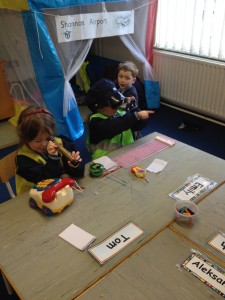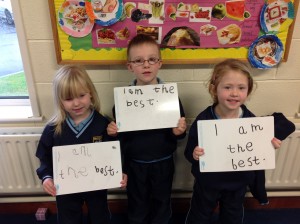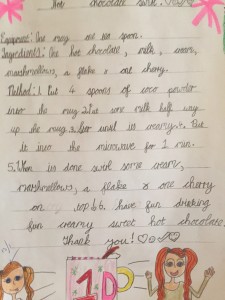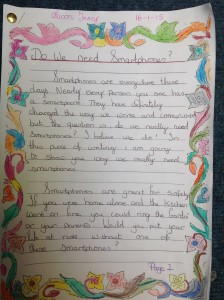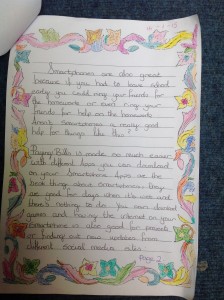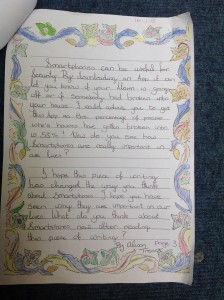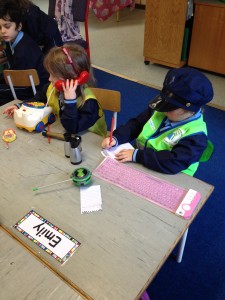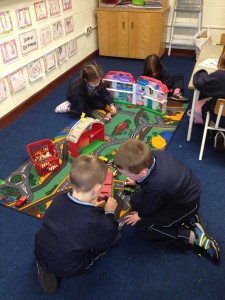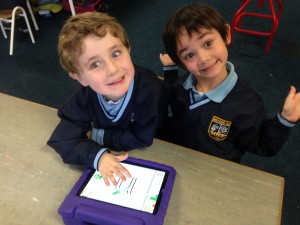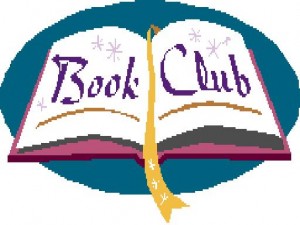English Literacy in Milford NS
Introduction
This English whole school literacy plan is regularly reviewed and updated.
A review of materials and strategies took place in May 2010 and May 2011. The specific areas of Infant reading Skills, Comprehension, the Writing process and Grammar were addressed as part of Milford NS Literacy Strategy in Sept 2011 and January 2012. An additional review of resources took place in May 2012 resulting in an updated inventory of texts, programmes and other related literacy schemes being compiled for each class level in Oral language, Reading and Writing. The decision was made to teach infant reading skills through a synthetic phonics approach. The “Building Bridges of Understanding” approach to the teaching of comprehension was introduced in September 2012.
This English Whole School plan was reviewed in May 2014 as part of the 3- year Whole School Literacy Strategy and shows strong performance in early reading skills in particular. A key component of the Whole School Plan from September 2014 is the focus on the explicit teaching of comprehension strategies and development of vocabulary study 3rd to 6th classes.
Digital literacy is a developing area in the literacy programme in Milford NS. There has been significant investment in IT (whiteboards, lap tops, ipads) and all classes have access to same. Class emails have been created and we aim to have all students from 1st to 6th engaging directly in digital literacy projects for the academic year 2014-2015
(To view the full English Literacy Plan please ask at the office.)
Rationale: In Milford N.S., we are committed to the holistic development of all pupils. We see the development of their fluency in the English language as being central to this process. We believe that the ability of our pupils to communicate fluently, confidently and effectively will contribute greatly to the development of their self-esteem and their personal growth. We also believe that their academic progress depends to a large extent on their ability to communicate orally and through the written word. In our school, therefore, we attach a high priority to giving pupils a command of English.
Aims of the English Literacy plan: Promote positive attitudes and develop an appreciation of the value of language – spoken and written.
This is central to the ethos of Milford N.S. – being a friendly and encouraging school for all pupils. Emphasis is placed on freedom of expression. Children are encouraged to greet their peers cordially. Teachers and other adult visitors to the school are to be spoken to with respect and in appropriate settings. Literature is valued in the school – encouraging the use of library, visits of authors, book clubs, World Book Day, Book Fairs, Book Club etc. Children’s written work is displayed and valued.
Create, foster and maintain the child’s interest in expression and communication.
Children are actively encouraged to address guests to the school – Sporting personalities, Storytellers, Authors, Health care Workers, Gardaí, Clergy, Representatives of Charitable institutions, Visiting Theatre etc. At all times, it is encouraged that the children will see it as their responsibility to represent their school through language in these situations. Children will have opportunity to address a wide range of individuals throughout their school life with courtesy and confidence. Children will also be afforded opportunity to address the teachers in school – seeking information, delivering messages etc.
Develop the child’s ability to engage appropriately in Listener- Speaker relationships.
Children are encouraged to listen to their teachers and to their peers with due attention to codes of conduct – pausing to let the other person speak – making the other person aware of their own need for communication and finally, giving their opinion.
Children are encouraged to listen to points of view which may differ from their own. Debating may be formally introduced in the senior standards. Children also get practice in making presentations for projects,
Develop confidence and competence in listening, speaking, reading and writing.
Children will experience “Circle Time” as a safe forum for the development of confident speaking and constructive listening. Situations for group discussion will be created through problem solving exercises, project work, quizzes, drama activities at all class levels.
Children will be encouraged to perfect writing skills through our policy of “draft /redraft” in creative writing. Children will see the final product as worthwhile and reflective of their efforts.Work will be displayed so as to create an audience for this endeavour.
Children will be afforded the opportunity to speak in front of an audience in the class situation, at school assemblies, audio presentations in school, at school concerts, at school masses and at the Christmas Pageant.
Develop cognitive ability and the capacity to clarify thinking through oral language, writing and reading.
A wide variety of materials and strategies will be used to achieve this aim: Building Bridges of Understanding, LSRT In Class support, Class Debates, discrete Vocabulary lessons, S.R.A. resources, Development of comprehension strategies, Research tools and materials (I.T., reference books, interviewing techniques etc.) Brainstorming, Mind mapping.
Enable the child to read and write independently.
Children are enabled to read through the use of strategies as outlined by the New Curriculum. From September 2011, Junior Infants have been taught reading skills using a Synthetic Phonics approach. Emphasis is placed on early acquisition of skills in reading and writing. Junior children will be supported in small groups through intervention of Class Teacher, LSRT team, SNA and Community Support. Shared Reading is key to this process and enhanced through the involvement of Parents or Guardians. Paired reading, with senior children reading with junior children is encouraged. Junior and Senior Infant children are progressed rapidly through synthetic phonic readers, developing blending skills and fluency of reading. Junior Infant children are screened at the end of the first academic year and interventions put in place by LSRT team in advance of Senior Infants.
Throughout the school, real books are promoted in the classroom reading lesson. Each class from 1st class upwards engages with a class novel and Library stock is updated regularly through funding, book clubs, Dept. grants, book- swap etc. Reading is promoted as a pleasurable activity.
Children are taught penmanship in the cursive style throughout the school. Emphasis is placed on a high standard of presentation of work.
There is a whole school approach to the teaching of writing. Writing begins in Junior Infants and free writing is promoted in the Junior Classes. Children are taught to write in a range of genres and specific months are chosen for each genre. Teachers are supported through sharing of relevant resources on www.aladdinschools.com.
The “draft redraft” method of creative writing is promoted within the school. Children see their written work as valued by their teachers and peers. Writing genres of Recount, Narrative, Report, Persuasive, Discussion, Response, and Correspondence are taught.
Enhance emotional, imaginative and aesthetic development through oral, reading and writing experiences.
Children are encouraged to express opinions and emotions through the English language curriculum. Children are provided with thought provoking passages, dilemmas, role-play opportunities, issues of current affairs etc. with the emotional response in mind. Children will be given U.S.S.R./DEAR time in class on a regular basis in order to foster independent reading. Children will be encouraged to view reading as a pleasurable activity.
Children will be afforded opportunity to enter Writing Competitions, Readathons, Sponsored Reading, Feile Luimni, Drama events and other school events- highlighting the central role of language in the school curriculum.
Broad Objectives, Content and Methodologies
The broad objectives, content and methodologies for the teaching and learning of oral language, reading and writing are detailed in this document. Each of these areas is presented under the four strand headings of the Revised English Curriculum, and reflects best current practice and pedagogy.
ORAL LANGUAGE
- Receptiveness to language
- Competence and confidence in using language
- Developing cognitive abilities through language
- Emotional and imaginative development through language
READING
- Receptiveness to language
- Competence and confidence in using language
- Developing cognitive abilities through language
- Emotional and imaginative development through language
WRITING
- Receptiveness to language
- Competence and confidence in using language
- Developing cognitive abilities through language
- Emotional and imaginative development through language
Junior Infants to Rang 6 Milford NS
Oral Language,
Broad Objectives
The aim of this plan is to provide a structured sequential programme for teachers to enable children to:
Gain pleasure and fulfilment from language activity
Develop the capacity to express intuitions, feelings, impressions, ideas and reactions in response to real and imaginary situations through talk and discussion, and the development of ideas.
Develop fluency, explicitness and confidence in communication.
Develop listening skills, language conventions, vocabulary, aesthetic response and language manipulation.
Encourage tolerance of the views of others.
Develop critical thinking which will guide pupils’ own behaviour and responses.
Reading
Broad Objectives Milford NS
The aim of this plan is to provide a structured and sequential programme for teachers to enable children to:
Develop print awareness, phonemic awareness, automaticity in decoding, word identification strategies and sight vocabulary.
Develop fluency of reading.
Develop their comprehension and analytical strategies.
Expand their understanding and usage of grammar, syntax and punctuation (prosodic reading)
Develop their appreciation of the richness and diversity of reading material.
Experience the pleasure and fulfilment to be gained from reading.
Writing
Broad Objectives Milford NS
The aim of this plan is to provide a structured and sequential programme for teachers to enable children to:
- Write clearly, correctly and fluently.
- Use a wide range of vocabulary.
- Use grammar and punctuation appropriately.
- Write in a wide variety of genres encompassing differing styles, purposes, audiences and level of formality.
- Experience opportunities to develop presentation, editing and publishing skills.
- Engage in collaborative writing experiences.
- Develop a high standard of penmanship.
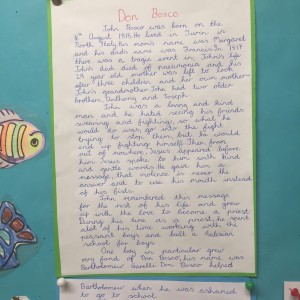
Resources for Oral language:
The Aistear programme supports and enhances the Infant Oral Language programme.
Junior Infants: Reading Zone Oral Language Programme (Folens)
Senior Infants: Reading Zone Oral Language Programme (Folens) Jolly Phonics
First Class: Chatterbox, Reading Zone Oral Language Programme (Folens), Jolly Grammar, Novel
Second Class: Chatterbox, Reading Zone Oral Language Programme (Folens), Jolly Grammar,
Novel, SRA Listening
Third Class: Chatterbox, Listening and Speaking Programme (Folens), SRA Listening, Novel,
Words Their Way (Pearson) (Introduced 2014/2015)
Fourth Class: Chatterbox, Listening and Speaking Programme (Folens), SRA Listening, Novel,
Words Their Way (Pearson) (Introduced 2014/2015)
Fifth Class: Chatterbox, Listening and Speaking (Folens), Novel, SRA Listening,
(2014/2015) Vocab their Way. New Literacy Directions (PALS)
Sixth Class: Chatterbox, Listening and Speaking (Folens), Novel, SRA Listening,
(2014/2015) Vocab their Way. New Literacy Directions (PALS)
Content Notes for Parents:
The Teaching of Reading:
In Milford N.S., we place particular emphasis on the acquisition of reading skills in Infants to Second classes. Children progress through the skills of decoding and blending, through automaticity and prosodic reading, to become fluent readers. Central to this process is the provision of appropriate levelled readers which let each child develop through the stages at an appropriate rate.
There has been a significant capital investment in reading materials in Junior Infants to Second class to facilitate this individual reading approach.
Each child will have the opportunity to progress through the Jolly Readers (from Read and See books to the red, yellow, green and blue Jolly Readers). From then on, the PM+ levelled readers (fiction and non-fiction) 15-30 are used as reading material in the levelled approach to individual independent reading. Parents have a key role in this process, monitoring nightly reading and signing the reading sheet to indicate successful completion of the book. From third class on, class kits of New Literacy Directions are in use from February 2015 to aid with the development of comprehension in a station teaching model.
Phonics: General Principles
- The programme is based on the Jolly Phonics synthetic phonics scheme from Junior Infants to Third
- It is a combined approach to reading and written spelling
- From September 2011, Junior Infants have been engaging completely with the Synthetic Phonic approach of Jolly Phonics as opposed to a combined Synthetic/ Analytic Phonics and Look and Say approach. We have been monitoring Junior Infants’ increased rate of phonic skill acquisition and have been supporting this approach through an increased supply of teaching resources/ personnel and changed methodologies. We believe that the Junior Infants will become earlier readers and develop greater skills of reading by delaying the introduction of formal readers until late in the second term. The children will only be given reading material which they have learned to read through the synthetic phonics approach. The Look and Say method will be used solely for Tricky Words learning.
- Children from Senior Infants upward will continue to build on this programme through the Jolly Grammar programme.
- All classes will attend to the components of the Jolly Phonics programme.
- A wide variety of resources will be employed to implement this programme….interactive materials, photocopiable materials, computer software, textbooks and the core, the Jolly Phonics/ Jolly Grammar scheme.
- An ideal lesson should follow these steps:
- Introduction/Review of the sound to be studied e.g. sh shop, ship
- Multi-sensory approach to learning of phonic element
- Isolation and identification of the sound: sh
- Blending of the sound with known endings, e.g. sh-ape, sh-ade etc
- Spelling the new words
- Writing the words
- Using the words in sentences and dictation
- Activities, e.g. word building sh_______
Assessment
Assessment in Phonics will mainly be through informal teacher observation of class and station teaching groups. Assessment will also be monitored through the use of a variety of activities and games. In addition the following strategies are used:
Junior Infants
- Children in Junior Infants are monitored closely through Station Teaching, especially in Second term to identify struggling learners. More supports (in class LSRT) will be put in place to ensure that the children grasp the skill and move with their peers.
- Formal assessment: Use of Jolly Phonics Checklist for Assessment of Phonological Awareness
- Use of Jolly Phonics/ Hodder and Stoughton Reading test. Planned LSRT support for Senior Infants.
- Senior Infants
– Children in Senior Infants are monitored closely through Station Teaching
- Formal assessment in May. Jolly Phonics Assessment testing. Micra T Level 1.
- Use of Checklist for Assessment of Phonological Awareness
Rang 1 – Rang 3 :
- Teacher monitors individual children through the daily reading and writing activities.
- Use of Checklist for Assessment of Phonological Awareness
- Use of standardised tests. Micra T, Drumcondra,.
- Referral to Learning Support Teacher for formal assessment of children who present with difficulties.
The programme presumes revision of the previous year’s work as outlined.
Resources: Junior and Senior Infants
Jolly Phonics Manual and Resources, Jolly Phonics Interactive programme for whiteboard, Phonics charts, Word Lists, Jolly Grammar 1, Tricky Words List
Rang 1 – Rang 3
Jolly Phonics, Jolly Grammar 1, Jolly Grammar 2, Jolly Grammar 3
Software Resources
Jolly Phonics interactive resources, Starspell installed on computers to enhance phonics programme, Wordshark, Emphasis on digital literacy and engagement with cloud resources such as Edmodo and Google classroom, Extensive collection of suitable software available in the Computer Software resource cabinet.
Writing: Progress indicators
Junior Infants – emergent writing
- Experiments with marks to represent writing
- Understands writing communicates messages
- Uses idiosyncratic writing in play
- Learns to form and to write all lower case letters.
- Assigns messages to own written and drawn symbols
- Learning transcription skills – acquiring knowledge of sound/symbol correspondence
- Can write first 20 tricky Words, Jolly Phonics Programme.
- Can write decodable single syllable words in list form
- Can spell cvcs (consonant- vowel-consonant- e.g. cat)and use in simple captions, phrases and a few simple sentences.
Senior Infants
- Spells CVCs well, and some 4/5 letter words Uses simple digraphs, vowel digraphs, consonant blend
- Writes 3 – 5 simple sentence
- Now using writing with the intention of communicating Experimenting with various forms of familiar writing such as: captions, lists and retells using simple language.
- Uses some sentence markers well e.g. capital letters and full stops.
First class – lower writing skills
- Spells CVCs well, and some 4/5 letter words
- Uses simple digraphs, vowel digraphs, consonant blends
- Writes 3 – 5 simple sentences
- using writing with the intention of communicating
- Experimenting with various forms of familiar writing such as Recount, Narrative , Poetry using simple language
Growing bank of high frequency words that they spell correctly (1-60 Tricky Words) - Uses phonically justifiable attempts at harder words – attempting letters on the basis of sound
- Uses common digraphs and blends securely – knows about “magic e”
- Handwriting becoming joined
Second class
- Their range of texts start to exhibit the conventions of writing, composed to share experience, information or feelings e.g. Recount, Narrative, Report, Procedural, Correspondence
- Can state the purpose of some text forms and the ideas that need to be included
- Growing bank of high frequency words that they spell correctly (1-72 tricky Words)
- Writes in simple and compound sentences, uses and, then, and, but as connectives
- Structure is a chained sequence of associations
- Uses sentence markers well e.g. capital letters, commas, speech marks and full stops.
- Able to write more than 10 lines
Third class
- Good spelling patterns established for basic regular words, and for familiar irregular ones Spelling of less common letter patterns known e.g. tion or ph. (suggest more….Jolly grammar 3 / Words their way )
- Students showing increasing control over the conventions of writing, such as punctuation, spelling and text organisation
- A growing bank of vocabulary and known words that are spelt correctly
- The range of text forms experienced grow to include reports, letters, recounts, character portraits, narrative, expository.
- Use of editing checklist for each genre
- Texts composed with a sense of purpose and audience
- able to organise ideas before writing through brainstorming, mind mapping, peer work, group work, drawing
- Using both simple and compound sentences with correct punctuation
Fourth class
- Use of sentence markers secure; understands sentence boundaries
Uses wider range of connectives, like if, so while, though, since, when, who, etc.
• Verb use wider, a few adjectives and adverbs used
• Fluent writing, understands basic story structure well
• Shows some awareness of reader and purpose in using different forms
• Able to retrieve, record and organise informational text to suit purpose and reader
• Sentence structure includes complex sentences, with related subordinate clauses
• Create a wide range of texts, demonstrating control over all elements e.g. biographies, debates, news reports, character sketches, play scripts and poetry in various styles
• A wide bank of vocabulary to aid precision and a range of spelling strategies to help tackle unknown words
• Plans for writing in a variety of ways
• Independently proofreads, edits and revises own writing
• The range of text forms experienced grow to include reports, letters, recounts, character portraits, narrative, expository. - Selects appropriate publication format to suit purpose and audience
- Use of editing checklist for each genre
Fifth class
- Fluent, expressive writing; accurate and automated use of secretarial skills
• Able to use planning, drafting and editing skills competently
• Able to proof-read and review work, alone or collaboratively
• Uses paragraphing
• Uses correctly laid out dialogue
• Selects vocabulary for effect i.e. loaded verbs, adjectives and adverbs
• Awareness of adaptation to purpose for audience grows
• Growing repertoire of text forms tackled i.e. newspaper articles, note-making for study skills, persuasive writing, letters of complaint, convey feelings / reflections / moods in poetry, write from another characters point of view etc.( see framework)
• Critiques own texts by evaluating the information retrieved, recorded and organised
• Selects and uses vocabulary/words for precision of expression, for shades of meaning and effect
• Uses grammar appropriately
• Paragraphs are used logically
• Spelling is accurate – a large range of spelling strategies 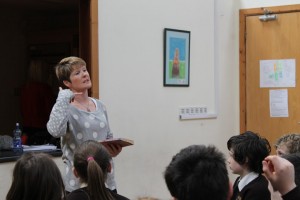
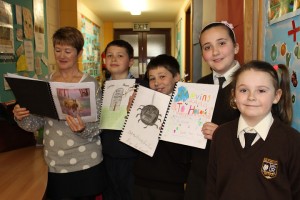
- Author Visit: Roisín Meaney tells Milford NS children about writing books
Sixth class – higher writing skills
- Writers reflect on the piece to ensure they have achieved their specific purpose for the intended audience
• Uses a range of planning techniques, through to drafting, refining and publishing
• Knows the conventions of a large range of text forms from non-fictional texts through the many facets of fictional text forms to the varied forms of poetry.
• Constantly critiques own writing
• Writes with conviction using a strong personal voice
• Understands the expectation of the audience
• Multi strategy approach to spelling
• Good adaptation to purpose and audience
• Sense of style
• Structure and coherence in flow of content
• Paragraphing secure
• Precise use of vocabulary
• Knows that own attitudes, values and beliefs impacts on the composition of text
• Focused fully on communicating meaning, autonomous writing as author, personal views and impersonal writing as well are both easily adopted
• Critical thinking developed through review, analysis, hypothesis, recollection and summary
• Extensive range of forms used
• Moving towards developing complex ideas, sustaining coherence and presenting information clearly 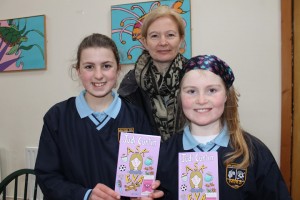
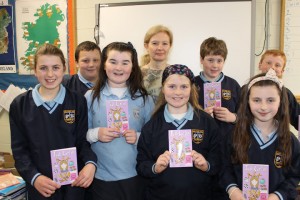
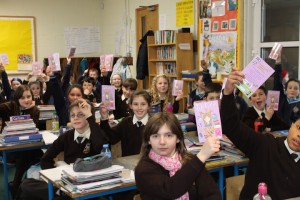
- Author, Judi Curtin, visits Milford NS
Penmanship: Children’s hand dominance will not be influenced.
- Junior Infants will be taught tripod grip.
- Junior Infants will form letters with tails.
- Children will be taught correct posture for handwriting, encouraging “helping hand” as per “Handwriting without Tears’ programme.
- Senior infants may join some letter combinations as per Jolly Phonics Programme.
- Cursive script is taught from 1st class.
- In senior classes, the use of ink pens is encouraged.
- Grammar- Functional Writing
Note: The Jolly Grammar Programme has been introduced from senior Infants to 4th class from Sept 2012. The pace and progression of this programme will be monitored over 2 years with a view to deciding if a full module per year will be taught.
The proposed plan is:
Jolly Grammar 1 Senior Infants
Jolly Grammar 1/2 First Class
Jolly Grammar 2/3 Second Class 2014
Jolly Grammar 2/3 Third Class 2014 Jolly Grammar 3/ 4 2015
Jolly Grammar 4 Fourth Class 2014
Prim Ed New Wave in English 5th Class 2014
Prim Ed New Wave in English 6th Class 2014
Classes 3rd to 6th have been supplied with Grammar Cards Sept 2012.
Senior Infants (from September 2012)
Jolly Grammar Programme: Jolly Grammar 1
- Capital Letters
- Sentences
- Proper Nouns
- Common nouns
- Alphabetical order
- a or an
- plurals
- Pronouns
- Alphabetical order
- Verbs
- Conjugating verbs
- Past tense
- Future Tense
- Adjectives
- Compound words
- Adverbs
1st Class
Jolly Grammar Programme
Jolly Grammar 1 (September 2014) JG1 22-36
- Antonyms
- Plurals
- Speech marks
- Questions
Jolly Grammar 2 (September 2014) JG2 1-22
- Alphabetical order
- Sentence writing
- Speech marks
- Commas in List
- Questions
- Exclamation Marks
- Proper Nouns
- Adjectives
- Plurals
- Possessive adjectives
- Homophones
- Adverbs
- Verb “to be” (present)
- Regular past
- Irregular past
- Dictionary
- Proof reading sentences
- Conjunctions
2nd Class
Jolly Grammar Programme / Literacy Leap Programme
Jolly Grammar 2 (September 2014) JG2 23-36
- Plurals, s, ies
- Prefixes
- Apostrophe
- Contractions
- Prepositions
- Suffix –ing
- Comparatives and superlatives
- Interesting words
- Commas in speech
- Parsing
Jolly Grammar 3 (September 2014)
- Dictionary
- Parts of Speech and parsing
- Simple tenses
- 3rd person singular. Verbs ending in (-y)
- Verb “to be” Past, present and future
- Present participle
- Present continuous
- Past continuous
- Proper nouns: places
- Proper adjectives
- Paragraphs
- Speech marks
- Future continuous
- Suffixes- less, ful
- Contractions
- Comparatives and Superlatives
- Adverbs… made adding -ly to adjectives
- Nouns acting as adjectives
- Adjectives: Made adding-y to nouns
- Irregular plurals
3rd Class
Jolly Grammar 2 (September 2014) Literacy Leap Programme
- Prefixes
- Apostrophe
- Contractions
- Prepositions
- Suffix –ing
- Comparatives and superlatives
- Interesting words
- Commas in speech
- Parsing
Jolly Grammar 3
- Dictionary
- Parts of Speech and parsing
- Simple tenses
- 3rd person singular. Verbs ending in (-y)
- Verb “to be” Past, present and future
- Present participle
- Present continuous
- Past continuous
- Proper nouns:places
- Proper adjectives
- Paragraphs
- Speech marks
- Future continuous
- Suffixes- less, ful
- Contractions
- Comparatives and Superlatives
- Adverbs… made adding -ly to adjectives
- Nouns acting as adjectives
- Adjectives: Made adding-y to nouns
- Irregular plurals
- The Subject of a sentence
- The object of a sentence
- Subject and object Pronouns
- Possessive pronouns
- Homophones “our”, “are”
- Homophones “there, their, they’re”
- Queswtions and exclamations in speech
- Prefixes
- Collective nouns
- Sentences and Phrases The subject and object of a sentence
Verb tenses Introduction of Grammar reference cards.
4th Class
Jolly Grammar 4 Programme Literacy Leap Programme
Verb tenses
- Identifying verb tenses
- The Subject and Object of a sentence
- Homophones :your, you’re
- Antonyms
- Plural Nouns
- Synonyms
- Concrete nouns
- Abstract nouns
- Possessive nouns: Singular
- Present Participles as Adjectives
- Comparatives and Superlatives
- Changing Verb Tenses
- Homophones: its, it’s
- Grammatical agreement: Subject and verb
- Comparatives and superlatives: Good, bad
- Homophones: to, too, two where, wear, were
- Suffix-al
- Possessive nouns: plural
- Root words: prefixes and suffixes
- Grammatical person
- Parsing verbs
- Questions and statements
- Simple and Compound sentences
- Homophones mix ups
- Noun Phrases
- Phrases, clauses, sentences
- Infinitives
- Onomatopoeia
- Hyphens
- Antonyms and Synonyms
Sentence construction
- Use of capital letters at beginning of sentences and full stops at the end of sentences.
- Use of the question mark.
- Use of the apostrophe.
- Use of exclamation mark Use of direct and indirect speech.
- Use of commas in lists. Inverted commas for direct speech
- Parts of Speech
- Revision and extension of the concept of Proper Nouns and Common Nouns.
- Proper Nouns such as John, Mary, Rex and Mallow get capital letters, while Common nouns such as boy, girl, dog and town get lower case letters.
- Use of collective nouns, e.g. herd of cattle, school of dolphins etc
- Masculine and Feminine nouns.
- Plural of nouns
- Verbs have tense. Past/present/future tense. .
- Adjectives
5th Class
Literacy Leap Programme
Sentence construction
- Use of capital letters at beginning of sentences and full stops at the end of sentences.
- Use of the question mark.
- Use of exclamation mark
- Use of commas in lists.
- Use of inverted commas for direct speech.
- Use of direct speech and indirect speech.
- Use of apostrophe
Parts of Speech
- Revision and extension of the concept of Proper Nouns and Common Nouns.
- Masculine and Feminine nouns
- Collective nouns
- Abstract nouns
- Plural of nouns
- Adjectives
- Past, Present and Future Tense Verbs
- Conjunctions
6th Class
Sentence construction
Use of capital letters at beginning of sentences and full stops at the end of sentences.
- Use of the question mark.
- Use of exclamation mark
- Use of commas in lists.
- Use of inverted commas for direct speech.
- Use of direct speech and indirect speech.
- Use of apostrophe
Parts of Speech
- Revision and extension of the concept of Proper Nouns and Common Nouns.
- Masculine and Feminine nouns
- Collective nouns
- Abstract nouns
- Plural of nouns
- Adjectives
- Verbs – Past, Present and Future Tense Verbs
- Conjunctions, Adverbs, Prepositions, Definite and Indefinite Article.
SPELLINGS
Regular class time will be timetabled for the teaching of spelling strategies.The convention of spelling will be achieved progressively through a multi-dimensional approach. This will include:
- Linking spelling with the development of phonological and phonemic awareness
- Linking it with onset and rime, see page 58
- Building up a bank of commonly used words
- Having a rich experience of environmental print
- Compiling personal word banks, eg personal names, local place names, seasonal words
- Using dictionaries and thesauruses
- Using strategies such as
- Synthetics phonics sounding out
- Predict, look, say, cover, write, check
- Music
- ICT
- Mnemonics
- Rhythm and rhyme
- Creation of word searches
- Aide memoires
- Spelling buddies
- Breaking words into syllables ( blending, beating, segmenting, counting and isolating syllables) declunking
- Exaggeration of the word
- Becoming familiar with common spelling rules
- Accepting approximate spelling in creative writing exercises such as “My Diary” Book Review etc
- Dictation, as a strategy, used from Junior infants.
- Spelling of Tricky Words.
RESOURCES
Jolly Phonics
Jolly Grammar 1-4
My Spelling Workbook scheme to be used from 4th to 6th
Words their way (Pearson)
Vocabulary their way (Pearson)
In Class Support (Team Teaching), Peer Assisted Learning, Collaborative Learning
Special emphasis will be placed on Teaching and Learning opportunities in Literacy in Milford NS from September 2014. Infant learners have been given special Station teaching and team teaching support since Sept 2011.From November 2014, the above learning strategies will be piloted in all classes with a view to developing comprehension and vocabulary skills.
Reading Resources
In Milford N.S., we place particular emphasis on the acquisition of reading skills in Infants to Second classes. Children progress through the skills of decoding and blending, through automaticity and prosodic reading, to become fluent readers. Central to this process is the provision of appropriate levelled readers which let each child develop through the stages at an appropriate rate. There has been a significant capital investment in reading materials in Junior Infants to Second class to facilitate this individual reading approach. Each child will have the opportunity to progress through the Jolly Readers (from Read and See books to the red, yellow, green and blue Jolly Readers). From then on, the PM+ levelled readers (fiction and non-fiction) 15-30 are used as reading material in the levelled approach to individual independent reading. parents have a key role in this process, monitoring nightly reading and signing the reading sheet to indicate successful completion of the book. From third class on, class kits of New Literacy Directions are in use from February 2015 to aid with the development of comprehension in a station teaching model. In addition to the class text books, which remain as class sets in the classroom, a Central Resource library is located in LSRT corridor. This is stocked on an ongoing basis and new titles are advertised to the staff.
Class Libraries
All classes are supplied with a class library, which is renewed regularly through central funding, County Library donations, funding from Parents Council and Book Fair commission. Teachers review their stock of books at the beginning of the academic year in terms of class level suitability. Teachers may rotate particular titles within class groupings.
Shared Reading
Shared Reading is promoted formally from Junior Infants to Fourth Class . Junior Infants commence Shared Reading in the second term. Series currently in use include Jolly Phonics Readers, Flying Start, PM+ Readers, Literacy Links, Storyworld, DK Learning Media, Ginn Reading, Oxford Reading Tree. Folens Readers. Reading of Quality fiction and non-fiction is also promoted within the shared reading scheme. Libraries are organised according to authors and genres.
Class Novels
Class novels are used from Rang 1 to Rang 6. There are several sets of novels currently available in the school. When selecting a class novel, the following issues will be considered
- Suitability for reading level/age of pupils
- Suitability of content/subject
- Teacher’s own interest in a particular novel
- Interests of a particular class
Use of Dictionaries
Dictionaries are used from First Class up. Formal time will be devoted to teaching the children how to use a dictionary correctly. For this purpose, a child friendly dictionary is used , and all pupils will be encouraged to obtain the same publication. The dictionary selected for use for First and second classes is Jolly Dictionary and for 3rd to 6th, it is Collins Primary Dictionary. Rang 5 and Rang 6 will also have some class copies of a more sophisticated dictionary and an appropriate thesaurus. Pupils are encouraged to use these.
Internet Resources for book related activities
www.enchantedlearning.com www.pcsp.ie
www.fireandwater.com www.scoilnet.ie www.worldbookday.com
Phonological Awareness Programme reviewed May 2014 Milford NS
Changes in the programme Sept 2014 reflect May 2014 consultation with class teachers and handover of pupil books.
Why Study Word Roots, Prefixes, and Suffixes?
Knowing the “building blocks” of the English language – prefixes, suffixes and root words – helps you to understand a word’s meaning and spelling convention.
Latin and Greek Word Elements
http://www.infoplease.com/ipa/A0907017.html
English is a living language, and it is growing all the time. One way that new words come into the language is when words are borrowed from other languages. New words are also created when words or word elements, such as roots, prefixes, and suffixes, are combined in new ways. Many English words and word elements can be traced back to Latin and Greek. Often you can guess the meaning of an unfamiliar word if you know the meaning.
A word root is a part of a word. It contains the core meaning of the word, but it cannot stand alone.
A prefix is also a word part that cannot stand alone. It is placed at the beginning of a word to change its meaning.
A suffix is a word part that is placed at the end of a word to change its meaning.
Often you can guess the meaning of an unfamiliar word if you know the meaning of its parts; that is, the root and any prefixes or suffixes that are attached to it.
Background Information to the Evolution of the English Language
Latin Roots, Prefixes, and Suffixes
http://www.infoplease.com/ipa/A0907036.html
Latin was the language spoken by the ancient Romans. As the Romans conquered most of Europe, the Latin language spread throughout the region. Over time, the Latin spoken in different areas developed into separate languages, including Italian, French, Spanish, and Portuguese. These languages are considered “sisters,” as they all descended from Latin, their “mother” language.
In 1066 England was conquered by William, duke of Normandy, which is in northern France. For several hundred years after the Norman invasion, French was the language of court and polite society in England. It was during this period that many French words were borrowed into English. Linguists estimate that some 60% of our common everyday vocabulary today comes from French. Thus many Latin words came into English indirectly through French. Many Latin words came into English directly, though, too. Monks from Rome brought religious vocabulary as well as Christianity to England beginning in the 6th century. From the Middle Ages onward many scientific, scholarly, and legal terms were borrowed from Latin.During the 17th and 18th centuries, dictionary writers and grammarians generally felt that English was an imperfect language whereas Latin was perfect. In order to improve the language, they deliberately made up a lot of English words from Latin words. For example, fraternity, from Latin fraternitas, was thought to be better than the native English word brotherhood. Many English words and word parts can be traced back to Latin and Greek( see link)

